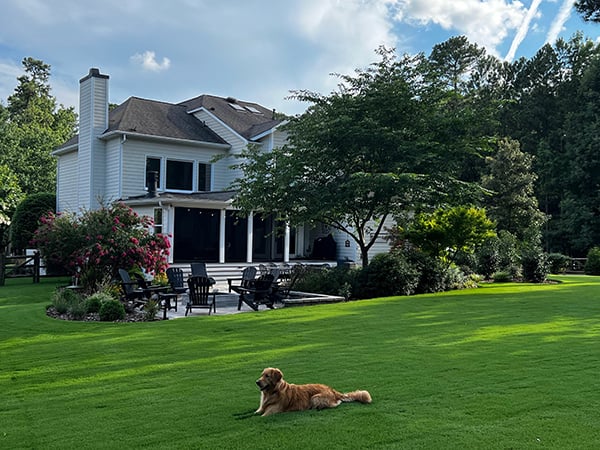

October Warm Season Lawn Care Tips for 2025


Let's start October's lawn tips with a 6-point highlight for Bermuda, Centipede, and Zoysia lawns. The growing season is winding down, yet there are important pointers to cover this month.
- 🌱 You've probably noticed that your lawn is not as vibrant green as it was last month. That's normal. It's slowly going dormant so don't fertilize with high nitrogen to perk it up.
- 🔵 Zoysia, Bermuda, and Centipede lawns get an application of our Professional Grade Fungicide in October to reduce the possibility of Large Patch occurring in the spring. Prevention in the fall is cheaper and easier than curing Large Patch in the spring!
- 🏡 The window is open until October 15th to prevent winter weeds by spreading pre-emergent herbicide. If you want to combat winter weeds before you even see them, apply pre-emergent before the window closes in mid-October. For warm season lawns we recommend 0-0-7 with pre-emergent since it has no nitrogen.
- 💦 Because granular pre-emergent herbicide and fungicide requires water to activate them, we recommend irrigating areas where you've spread the granules. Specifically for pre-emergent, irrigate enough to wet everything down so the granules dissolve a little and start to form the barrier that kills the germinating weed seeds. If it doesn't rain soon, you may want to "water in" the granules at least twice before October 15th.
- 💦 If you're in an area that had heavy rainfall, consider reapplying pre-emergent a second time if you think it was washed away by excessive rain.
- 🍁 Leaves are starting to fall off trees and accumulate on lawns. Start blowing or raking off those leaves so your green lawn doesn't get smothered. This time of year, I'm out there every few days blowing them off before many accumulate.
🎃 I've planted horror-ible Halloween puns throughout the remainder of these warm season lawns tips for you to stalk down, so keep skimming!
Fall Armyworm Alert
Armyworms will bedevil lawns until first frost this fall. Learn the signs, scout daily, and act quickly if you see these hobgoblins. Read what to look for in our Fall Armyworm article.
Your lawn is not doomed! To ward off armyworms and feed your lawn, we recommend 5-10-30 with Acelepryn insecticide for all lawns. It's safely low in nitrogen and the phosphorus and potassium will benefit overall health. 
Fertilizing Tips
- Stop fertilizing your lawn! Do not fertilize, topdress, or aerate warm-season lawns in October or anytime in the fall; wait until spring. Unless you like the specter of a frost-damaged lawn, it's time to let your lawn slowly go dormant. High nitrogen promotes tender new growth that can be damaged by frosts, so don't use high nitrogen fertilizers and save yourself the fright.
- As mentioned in the beginning, we recommend pre-emergent herbicide through October 15th. For warm season lawns, avoid pre-emergents with nitrogen so you don't push extra growth when it should be going dormant. "Winterizers" you'll find in big box stores have too much nitrogen. Our 0-0-7 with Barricade is a safe pre-emergent for warm season lawns.
- Learn why Winterizers are not the best solution for lawns (and how they might actually damage them) in our latest blog, "Does Your Lawn Need Winterizer Weed & Feed, or Not?"
- Since possession by fall armyworms is real, we recommend our 5-10-30 + Acelepryn insecticide. The low nitrogen (the 5 in the ratio) is safe for warm season lawns.
- Order 5-10-30 with Acelepryn for pick up or delivery or check out our Lawn Coach subscription.
Read the Best Times to Apply Fertilizer >>
Weeding Tips
- The window for applying pre-emergent herbicide is open through October 15th. Pre-emergent will prevent winter weed seeds from rooting. It kills off the first root that comes out of the seed and you'll never see the rest of the weed germinate. It's like sorcery!

👍 Rule of Thumb: Don't apply pre-emergent to new sod because it will also inhibit your new lawn from rooting. Apply it after one full growing season when your lawn is fully rooted in and you can no longer pull up areas of the sod, after you’ve mowed it at least three times, and after you can no longer see the seams.
👍 Rule of Thumb for Drought (this is an important repeat from the top): Because granular pre-emergent herbicide requires water to activate it, we recommend irrigating areas where you've spread the granules. Irrigate enough to wet everything down so the granules dissolve a little and start to form the barrier that kills the germinating weed seeds. If it doesn't rain soon, you may want to "water in" the granules at least twice before October 15th. - For weeds you see now in established lawns, apply post-emergent liquid herbicides like our grassy and broadleaf herbicides. Please read the label and follow all instructions for best results and safety.
👍 Rule of Thumb: It's okay to apply a post-emergent liquid herbicide after you've mowed your new lawn 3 to 4 times. - Pulling by Hand: If some weeds have escaped your pre-emergent routine and regular mowing, we recommend hand pulling to work off that Halloween candy you might have been sneaking.
- Mowing: Mow those weeds down before they go to seed. Mowing is an effective way to suppress weeds because it cuts off flower/seed heads and that stops weeds from making more weeds, thus breaking the life cycle. If you have bad weeds, mow on a weekly routine and don't let the weeds get ahead of you.
- Mulch suppresses weed seeds in flower beds. Spread your favorite mulch 2-4" thick and keep it 1-2" away from touching the trunks or stems of your plants.
- Nutsedge is an edible weed that haunts lawns and is particularly hard to exorcise, even if you drink it. Spooked or intrigued? Read how to get rid of nutsedge in your lawn and flower beds and possibly drink it too: October Weed of the Month: Nutsedge
Leaves are light yellow-green with a waxy coating. Like dallisgrass, they overshadow turf and will shoot up like a wood sprite and grow taller than the lawn, even if you don't miss a mowing.
Mowing Tips
- Continue to mow warm season lawns at the recommended height until they go dormant, possibly by the end of November. It's critical to keep up this practice so that your lawn looks great next spring.
- Look up the mowing height for your lawn here: Summer Mowing for Warm Season Grasses
- Mowing New Sod: Did you lay new sod? Our saying is to "mow as soon as there is something to mow." In fact, mowing will promote growth! So don't be timid. Mow it! Read: How Soon Should I Cut My Grass?
If you have a Tall Fescue lawn (the best cool season lawn for the Southeast), check out our October Lawn Tips for Tall Fescue.
Got questions? Leave a comment below.
Come back next month for November's Lawn Tips for Warm Season lawns!
If you're new here, subscribe to our emails to get this information in your inbox every month.




